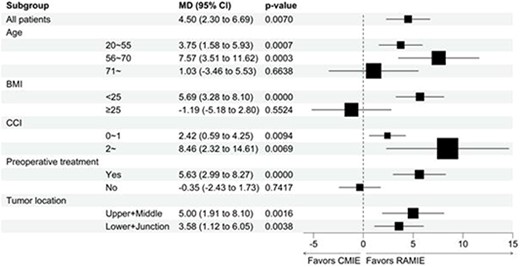-
PDF
- Split View
-
Views
-
Cite
Cite
Yin-Kai Chao, Jui-Ying Lee, Wen-Chien Huang, Jang-Ming Lee, Yau-Lin Tseng, Hung-I Lu, Jian Ying Lye Tiffany, 395. SUPERIOR PERFORMANCE OF ROBOT-ASSISTED MINIMALLY INVASIVE ESOPHAGECTOMY OVER THORACOSCOPIC APPROACH: A MULTI-INSTITUTIONAL STUDY ON SHORT-TERM OUTCOMES, Diseases of the Esophagus, Volume 37, Issue Supplement_1, September 2024, doae057.150, https://doi.org/10.1093/dote/doae057.150
Close - Share Icon Share
Abstract
Robot-assisted minimally invasive esophagectomy (RAMIE) and conventional minimally invasive esophagectomy (CMIE) are superior to open techniques. However, few studies have directly compared the outcomes of these two approaches.
A retrospective study was conducted on a dataset from six medical centers, encompassing patients with esophageal squamous cell carcinoma (ESCC) who underwent minimally invasive esophagectomy between 2015 and 2022. Perioperative outcomes were compared after applying inverse probability of treatment weighting (IPTW).
The study included 577 patients (RAMIE, 206; CMIE, 371). After applying IPTW, RAMIE was found to yield a higher number of mediastinal nodes compared to CMIE (14.86 versus 12.66, p=0.017). RAMIE was notably effective in retrieving upper mediastinal left RLN nodes, averaging 1.97 nodes versus 1.14 nodes harvested by CMIE (p<0.001). This was coupled by a significant decrease in nerve palsy rates (13.9% versus 22.8%, p=0.020). A significantly larger percentage of patients in the RAMIE group had an uncomplicated postoperative course (51.8% versus 34%, p<0.001). RAMIE also led to a reduction in pneumonia rates (8.6% versus 15.2%, p=0.041) and was linked to a shorter length of stay (LOS; 16.64 versus 21.14 days, p=0.007). The advantage of RAMIE in reducing LOS was especially pronounced in patients with a high Charlson comorbidity index (mean difference, 8.46 days; p=0.0069) and those who underwent preoperative therapy (mean difference, 5.63 days; p<0.001).
In ESCC, the use of RAMIE led to fewer pneumonia and faster recovery compared to CMIE. Additionally, RAMIE significantly improved the feasibility and safety of performing LND along the RLN.




